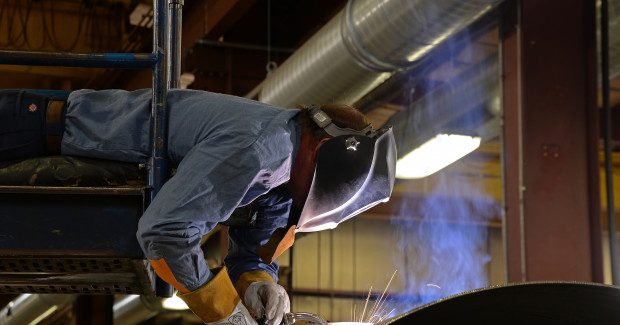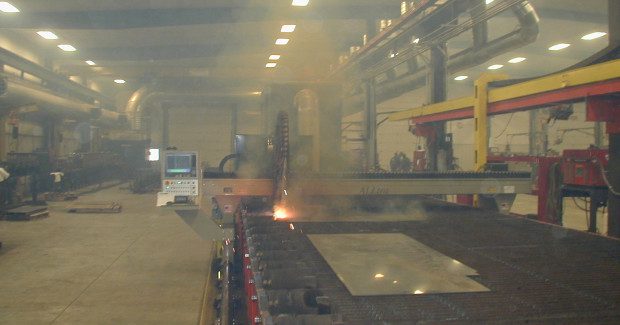Clean Air, Productivity and the Bottom Line
Poor concentration. High error rates. Absenteeism. Do your employees seem to have their heads in the clouds lately?
Posted: December 23, 2015
If those clouds are made of dust and fumes from welding or other manufacturing processes, you might want to take a closer look. In addition to known long-term health risks, poor air quality can have an immediate and insidious effect on worker productivity and your bottom line.
COUNTING THE COSTS OF POOR AIR QUALITY
Poor air is more than just unpleasant for workers. Welding fumes, dust and other contaminants have both immediate and long-term impacts on workers. Long-term health impacts of exposure to toxic fumes can include respiratory problems, kidney disease, nervous system damage and several kinds of cancer. However, short-term exposure can also result in immediate impacts on worker effectiveness. Acute effects such as eye irritation, difficulty breathing or nausea make it difficult for workers to concentrate and more likely that workers will go home early or miss subsequent days.
Even in plants that are meeting minimum air quality standards as defined by OSHA and the EPA, air quality issues can have a real and measurable impact in the form of reduced concentration levels, higher error rates and increased health-related absenteeism. These impacts result in lower overall productivity for plants with poor or marginal air quality compared to environments with better air quality. Here’s what the science says:
- Indoor air quality has been shown to have significant impacts on both worker productivity and product quality in factory environments.
- Recent studies by the International Center for Indoor Environment and Energy show that improved indoor work environments – as measured by reduction in indoor pollutants, enhanced ventilation rates and effectiveness, and improved thermal comfort – can increase productivity by 5 percent to 10 percent.
- A study by the University of San Diego Burnham-Morse Center for Real Estate estimates that worker productivity gains with improved indoor air quality average $5,204 per worker.
- Poor indoor air quality (IAQ) has been estimated to cause six additional lost workdays per year for every ten employees.
https://youtu.be/MFYkPNG7Cjw
The EPA estimates that the costs associated with healthcare expenses and lost productivity due to indoor air quality issues in the workplace could be in the tens of billions of dollars each year. Similarly, OSHA has estimated that worker absences and reduced efficiency resulting from poor air quality cost U.S. companies $15 billion annually. And this doesn’t include the rising cost of lawsuits and legal liability associated with air quality issues that impact worker health.
THE HIDDEN EFFECTS ON RECRUITING AND RETENTION
The immediate impact of air quality on workers may be easy to recognize, but other effects are more subtle and harder to measure. Indoor air quality has a direct, but often underappreciated, effect on employee recruitment and retention, increasing hiring and training costs for companies with poor air quality.
Increasingly, work environment – including air quality – plays a large role in job decisions for skilled workers. Younger workers tend to be more educated about the potential impact of welding fumes and other contaminants on their health. They also want to work in environments that are pleasant and comfortable. As a result, fewer young workers are choosing manufacturing as an occupation. At the same time, an aging workforce makes attracting young people to these jobs an urgent priority. According to the American Welding Society, by 2020 we can expect a shortage of 290,000 skilled welding professionals. For manufacturing as a whole, The Manufacturing Association and Deloitte anticipate a shortage of two million skilled workers by 2025.
Years of low levels of recruitment and training in the industry will mean that skilled, experienced workers will have their pick of jobs. Increasingly, these workers are voting with their feet. When comparing a job offer from a facility that appears dirty, smells bad and has visible fumes, versus an offer from a company with clean facilities and fresh-smelling air, many workers will select the latter – sometimes even if the pay is less. The flip side of the coin is employee retention. Air quality has a big impact on worker satisfaction. When skilled workers are in high demand, they are likely to jump at opportunities to transfer to work environments that are more pleasant to be in and have fewer long-term health concerns. This results in higher turnover for plants with poor air quality.
These turnover rates can be a real productivity killer. Highly skilled and experienced workers are simply more productive than their less experienced or well-trained counterparts – and even highly qualified workers will be less productive in their first weeks or months in a new welding shop as they learn the ropes. High turnover costs manufacturing plants in a number of ways:
- Lost productivity due to reduced staffing while looking for replacement workers.
- Hiring and training costs associated with finding and onboarding new employees.
- Reduced productivity for new employees as they learn the specific requirements and processes of their new jobs.
THE ECONOMICS OF IMPROVED AIR QUALITY
Fortunately, manufacturing facilities that put solutions in place to improve air quality can expect to see those investments pay off in real economic terms. Some studies have shown that investments in air quality improvement can pay off in as little as two years in terms of improved productivity, reduced absenteeism and higher retention rates. For these reasons, savvy plants are making air quality and a pleasant working environment a priority. Good ventilation systems and other indoor air quality measures can help employers improve employee satisfaction, productivity and retention, and make sure their shop stands out to new recruits. By reducing employees’ exposure to dangerous dusts and fumes, facilities may also see reduced healthcare costs and can significantly lower the risk of potential health-related lawsuits from employees.
When you add it all up, improving indoor air quality in manufacturing facilities makes good economic sense. But sometimes it’s not easy to know what you need. Experienced ventilation system engineers can help plant managers evaluate their current air quality risk profile and recommend solutions that will help them get the best value and results for their money. An investment in air quality will pay off in years to come through higher worker productivity, reduced absenteeism and better retention and recruitment. If you want to attract and retain the best workers, and keep them performing to the best of their ability, the air they breathe should be one of your top priorities.






